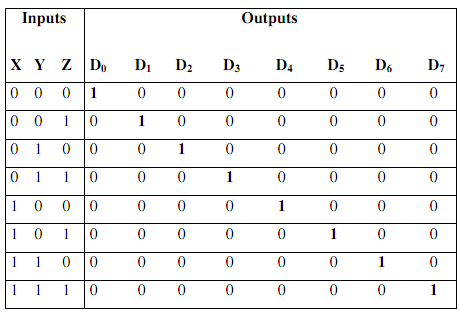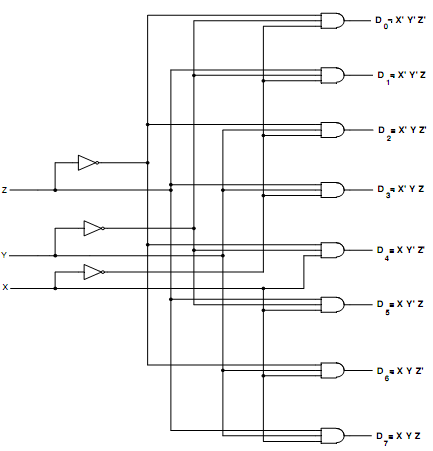What is a decoder? Draw the logic circuit of a 3 line to 8 line decoder and explain its working.
Ans. Decoder: it is a combinational logic circuit which converts Binary words in alphanumeric characters. Hence the inputs to a decoder are the bits 1, 0 and combinations of that. The output is the equivalent decimal number. This converts binary information from n input lines to a maximum of 2n single output lines. If the n-bit decoded information has unutilized or don't-care combinations, the decoder output will contain less than 2n outputs.
Working: The logic circuit of 3 to 8 line decoder is demonstrated in fig. (a). The 3 inputs (x, y, z) are decoded in eight outputs from D0 to D7, all output representing one of the minterms of the three-input variables. The three inverters give the complement of the inputs and every one of the eight AND gates produce one of the minterms. An exact application of such decoder is a binary-to-octal conversion. The input variables may show a binary number, and the outputs will after that show the eight digits in the octal number system. Though, a 3-to-8 line decoder can be utilized for decoding any 3-bit code to give eight outputs, one for each component of the code.
The process of the decoder may be verified from its input and output relationships illustrated in Table .The table illustrates that the output variables are equally exclusive since only one output can be equivalent to 1 at any one time. See the case when X=0, Y=0 and Z=0, and the output line D0 (X', Y', Z') is equivalent to 1 shows the minterm equivalent of the binary number currently available in the input lines.

Truth Table of 3-to-8 line Decoder

Fig. (a) Logic Circuit of 3-to-8 line Decoder